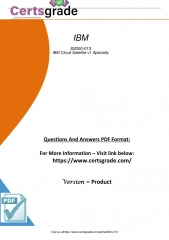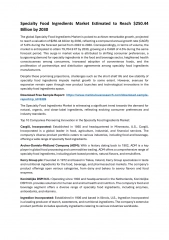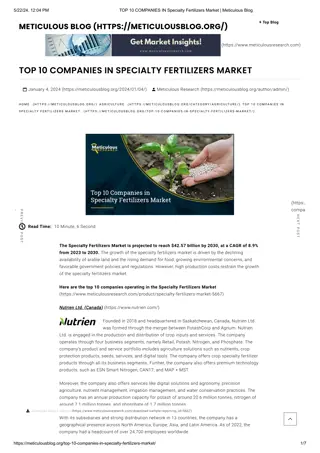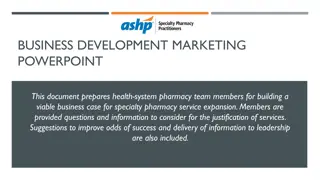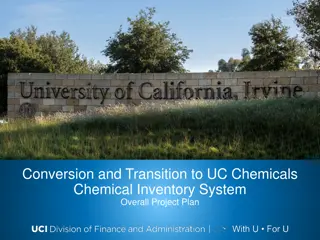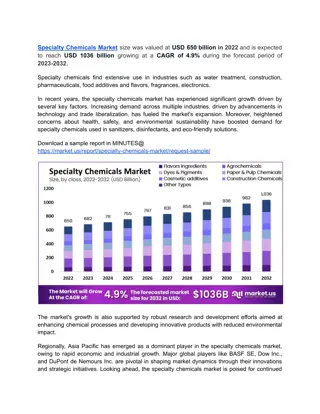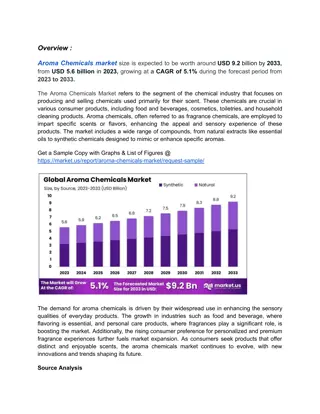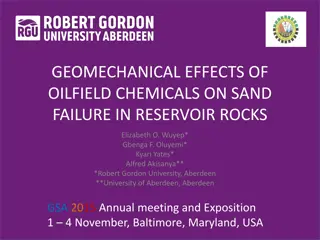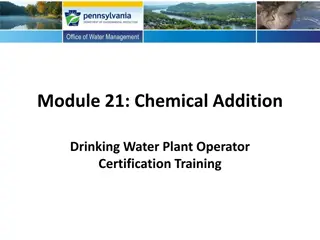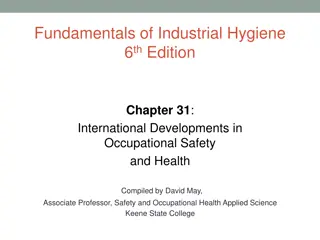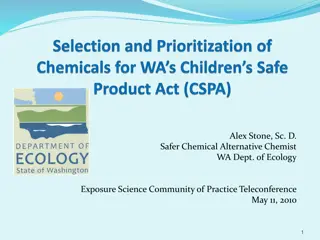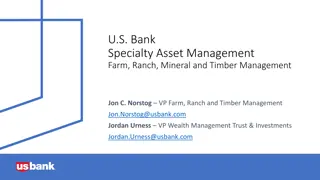Insights into Specialty Chemicals Industry: Perstorp Plantwide Control
Explore the intricacies of specialty chemicals plants through the lens of Perstorp's experience, covering topics such as control objectives, degrees of freedom, and characteristics of these complex facilities. Discover the unique challenges and considerations in controlling processes for specialty chemicals, from synthesis to separation, in an industry where expertise and design play pivotal roles.
Download Presentation

Please find below an Image/Link to download the presentation.
The content on the website is provided AS IS for your information and personal use only. It may not be sold, licensed, or shared on other websites without obtaining consent from the author.If you encounter any issues during the download, it is possible that the publisher has removed the file from their server.
You are allowed to download the files provided on this website for personal or commercial use, subject to the condition that they are used lawfully. All files are the property of their respective owners.
The content on the website is provided AS IS for your information and personal use only. It may not be sold, licensed, or shared on other websites without obtaining consent from the author.
E N D
Presentation Transcript
On PWC for chemical plants Krister Forsman 2016-09-29
Outline Short facts about specialty chemicals industry and Perstorp Plantwide control: Degrees of freedom Throughput manipulator selection Specifying control objectives K. Forsman, 2016-09-29, No. 2
Characteristics of chemical plants (A view slightly biased by Perstorp experience)
Control: What differs between different industries? For mature processes, with a large installed base, there are standard solutions; often quite advanced. Often packaged by control system suppliers. Oil refineries (~800 world wide) Paper machines (2000) For specialized processes, that are fairly unique, local expertise has to design the controls. Only a handful of plants in the whole world Often confidential processes K. Forsman, 2016-09-29, No. 4
Characteristics of typical specialty chemicals plants Synthesis (reaction) followed by a large number of separation steps. Reaction is often batch-wise, and separation continuous. Separation can be a number of sequential distillations, evaporations, crystallizations, filtrations, centrifuges, decanters, etc. High value side streams (byproducts); many recycle loops The separation part of the plant is much more complex than the synthesis. Complex topologies Many internal buffers Plants operate 24/7 Controlled by computerized control systems Products are liquid, solid or gas K. Forsman, 2016-09-29, No. 5
Topology for plant with multiple separations (Loosely based on a true story) Waste Raw material 1 Raw material 2 Reaction Separation Separation Product 1 Raw material 3 Waste Bagging Product 3 Separation Separation Product 2 Main product Bagging K. Forsman, 2016-09-29, No. 6
In reality, much more complicated How many throughput manipulators? What is the production rate? What does shutdown mean ? K. Forsman, 2016-09-29, No. 7
The Perstorp group short facts Specialty chemicals company with focus on organic chemistry Turnover 2015: ~1200 MEUR Profit 2015: ~180 MEUR Main owner: PAI Partners, a French equity company 1500 employees Products: Mainly additives for other chemical industries Additives in paints and coatings, plastic-processing and automotive industries Thermoplastics, plasticizers, solvents, bleaching agents, etc but also end products like feed additives and bio-diesel. Global Technology has a group of 4-5 people working full time on proces control and industrial IT. K. Forsman, 2016-09-29, No. 8
Nine production sites Bruchhausen Castellanza Gent Stenungsund Perstorp Toledo Warrington Waspik Zibo Totally ca 40 plants ~50 000 variables ~5 000 control loops K. Forsman, 2016-09-29, No. 9
Degrees of freedom K. Forsman, 2016-09-29, No. 10
Catalytic incineration of VOC 5 manipulated variables 11 process variables What to control? How? TT 05 Atmosphere Electric heater Heat TT 12 exchanger TT 13 TT 16 TT 11 Variable speed fan Reactor TT 01 Atm. TT 03 PT 15 FT 14 TT 02 Waste gases from reactor, distillation, evaporation, vacuum system etc TT 04
DoF central concept in PWC Control engineering point of veiw: Number of independent manipulated variables Typically: number of valves. Causality important. Chemical engineering point of view: Number of independent variables in steady state The number of controlled variables = number of DoF Differ between dynamic and static DoF Inventories have to be controlled. Each one consumes a dynamic DoF. The remaining ones quantify the static behavior of the process. Most expositions lack a rigorous mathematical definition. This should be possible using algebraic concepts, such as transcendence degree of extension fields. K. Forsman, 2016-09-29, No. 12
Different competencies for different levels in the structure Closing a loop does not reduce the #DoF. We have to choose setpoint. Moving DOFs upwards in the hierarchy requires several competencies. Example 1 Example 2 LC.SP TC.SP Buffert optimization Process engineer Crystallization theory Process engineer LC TC Cascade control Control engineer PI-controller Control engineer FC Valve PI-controller Control engineer Valve K. Forsman, 2016-09-29, No. 13
Aspects of Plant wide control The throughput manipulator K. Forsman, 2016-09-29, No. 14
Throughput manipulator determines production rate A plant always has a variable that determines the troughput rate: It is normally a flow, the master flow . The gas pedal Called TPM = throughput manipulator If you have very large buffers between process areas, where level is not controlled, you may in fact have several TPMs. The operator gives the setpoint for the TPM. All other flows are given indirectly by the master flow, typically through level controls. You have to select a variable that is TPM: the choice is either deliberate or inadvertent. K. Forsman, 2016-09-29, No. 15
Choice of TPM: Bottle neck or minimum variation The two most common ways of selecting which variable is TPM: The flow closest to the bottle neck. The flow most important to keep constant. Reason: The TPM flow will be the most constant one. If no thought is given to the choice, then often the first flow in the plant becomes TPM. K. Forsman, 2016-09-29, No. 16
Unconsidered choice of TPM gives suboptimal operation Example: In a plant the feed of reactant 1 was chosen as TPM. The filtration step is the bottle neck. Which variable should be master flow in order to give maximum production with minimum number of SP changes? Operator SP Reactant 1 FC1 Post reaction Reactor Filtration Storage FC3 FC4 FC5 Reactant 2 FC2 K. Forsman, 2016-09-29, No. 17
Solution: Filter feed = TPM The setpoint for the filter feed flow is set by operator / plant manager. Other flows are a consequence of level controls or similar. Operator SP Reactant 1 FC1 Post reaction Reactor Filtration Storage FC3 FC4 FC5 Reactant 2 FC2 K. Forsman, 2016-09-29, No. 18
Inventory controls; real example Four tanks in series. One thruput manipulator (TPM). Level controllers. The radiating rule gives the control topology below. TPM 1 2 3 4 FC1 FC2 FC3 FC4 FC5 K. Forsman, 2016-09-29, No. 19
Radiating rule is not mandatory The topology below will also work. Easy to realize that the entire process can be stabilized using only PI controllers. Disadvantage: LC2 won t work if LC1 is in manual. However, it has an advantage too... TPM 1 2 3 4 FC1 FC2 FC3 FC4 FC5 K. Forsman, 2016-09-29, No. 20
FC1 sometimes fixed At times, the operator needs to run flow 1 with fixed SP. Since tank 1 is much smaller than tank 2, it is easier to handle the process if level 1 is still controlled automatically, and FC1 is used to manually control level 2. TPM TPM 1 2 3 4 FC1 FC2 FC3 FC4 FC5 TPM TPM 1 2 3 4 FC1 FC2 FC3 FC4 FC5 K. Forsman, 2016-09-29, No. 21
This can be made to work too... ...meaning all levels can be stabilized using only PI-controllers. TPM K. Forsman, 2016-09-29, No. 22
Even this works But not if both LCs are PI-ctrl. One has to be a PID. Maybe this can be made into a general indicator? If you can t stabilize the plant without resorting to using derivative action, the structure is not good . TPM FC1 FC2 LC1 LC2 K. Forsman, 2016-09-29, No. 23
TPM selection and consistency How many of the flows can be set independently? Which combinations of flows? FC FC FC FC FC FC FC K. Forsman, 2016-09-29, No. 24
This works TPM q0 LC LC FC FC FC q1 FC FC LC q2 FC FC LC K. Forsman, 2016-09-29, No. 25
This is inconsistent TPM TPM FC FC FC TPM FC FC FC FC K. Forsman, 2016-09-29, No. 26
This is also inconsistent TPM FC FC FC TPM FC TPM FC FC FC K. Forsman, 2016-09-29, No. 27
Algorithm for finding all consistent schemes q1 q2 q3 1 2 q4 q5 1 1 0 1 0 0 0 0 1 1 0 1 0 0 3 = x 0 0 0 1 1 1 1 0 0 0 0 0 1 1 q6 q7 4 K. Forsman, 2016-09-29, No. 28
Most plants have several TPMs This is possible because there are intermediate buffers inside the plant. An indicator of this is that there is a large number of setpoint changes for some of the flows. Visible e.g. in operator action statistics. Why not have a completely automated plant where buffer levels are controlled automatically (by P-controllers)? Bullwhip effect Difficult to foresee all possible scenarios K. Forsman, 2016-09-29, No. 29
An overlooked issue in TPM selection The choice of TPM affects the precision in production planning: If the TPM is located far away from the point where production is measured, it becomes more difficult to adhere to the production plan. Plant management / operator has to guess what speed to choose in order to produce the right number of tons. Tons produced TPM setpoint K. Forsman, 2016-09-29, No. 30
PWC issues should be included in control projects The plant-wide control strategy is a very important tool for making a plant operate efficiently. Degrees-of-freedom analysis for enumerating all possible PWC schemes Thruput manipulator selection Unfortunately PWC is often not taught in courses. Somehow falls between chemical engineering and control theory. Process engineers rarely use a systematic approach to choose PWC strategy. But PWC thinking should be a part of all investment projects and control projects. K. Forsman, 2016-09-29, No. 31
Control specifications K. Forsman, 2016-09-29, No. 32
Specifying control objectives Examples of control specifications are Keep the PV as close as possible to the setpoint when there are disturbances, while not moving the MV too much. The controller should be possible to run in Auto during startups. Minimize outlet flow variations while keeping the level within some limits. Maximize reactor throughput while keeping temperature within limits. It is often hard to obtain a scientific description of the control objectives. There may be implicit requirements. Control engineers don t always have a deep understanding of the process. Process engineers are normally not used to specifying control objectives. What are constraints and what is target function? K. Forsman, 2016-09-29, No. 33
Example: Split flow Liquid (incompressible) flow. The total flow is controlled by FC1. Introduce a way to split the flow between stream 1 and stream 2. Of course, controlling both flow 2 and flow 3 is impossible. FC1 FT2 FT Stream 1 FT3 Stream 2 K. Forsman, 2016-09-29, No. 34
Simple solution: ratio control Traditional ratio control (below) lets the operator specify flow 3 as a factor of flow 2. FV2 is fixed (but not closed). This solution was not accepted by operational staff. They sometimes have to set flow 2 as a factor of flow 3. Total pressure drop should be as small as possible Which structure can we use now? FC1 FV2 FT FT2 Ratio entered by operator x FC3 FT3 FV3 K. Forsman, 2016-09-29, No. 35
This solves the split control problem FC1 FV2 FT FT2 PV OP x + FC4 SP Desired split 0-1 FT3 FV3 Desired split FT2/Total is entered by the operator K. Forsman, 2016-09-29, No. 36
Some things should be left to the operators Complex control solutions make it hard for the operator to know which situations are handled automatically. Sometimes the control solution does not cover all the scenarios that the operator has to handle. Some requirements were forgotten in the specifications. More automation may increase the cognitive load on the operator. Compare: Adaptive cruise control K. Forsman, 2016-09-29, No. 37
Thank you! K. Forsman, 2016-09-29, No. 38




